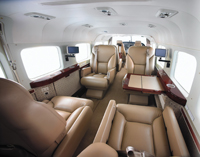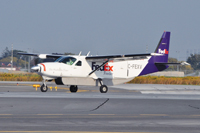
Features
Operations
A complete performance
If aircraft were cars, then the Cessna Caravan would be a fuel-efficient minivan
November 4, 2010 By James Careless
If aircraft were cars, then the Cessna Caravan would be a fuel-efficient minivan. Despite the fact that it only has a single Pratt & Whitney PT6A-114A turbine engine, the current Caravan Model 208 can carry up to 10 people (9 passengers/1 pilot) or haul 4,062 lbs. (1,846 kg) of cargo in its 340 cubic foot cabin (9.6 cubic metres). As for range, the Caravan 208 can travel 946 nautical miles (1,752 km) at a cruise speed of 186 ktas (344 km/h) with a certified ceiling of 25,000 ft (7,620 m).
 |
|
| Adding floats to the Caravan 208 turns it into the perfect Canadian workhorse: the Caravan Amphibian. PHOTOs: CESSNA |
Want to take off and land on water? Then add floats and the Caravan 208 becomes the Caravan Amphibian. Need more capacity for passengers or cargo? Then choose the Grand Caravan (9 passengers plus 1-2 pilots) or Super Cargomaster, each of which has four feet added to its fuselage (maximum payload 4,682 lbs./2,210 kg). To add even more cargo space, strap on an exterior cargo pod. Think of it as a roof-mounted container atop a stretched minivan; you get the picture.
The minivan analogy even explains the Caravan’s sales longevity: 2010 marks the aircraft’s 25th anniversary, with 2,000 aircraft produced since 1985. “People want the Caravan for so many different missions,” says Ken Wilson of Wilson Aircraft, an Aurora, Ont. company that is the Eastern Canadian Caravan Authorized Sales Representative. “During the recession, we saw sales drop for all aircraft except the Caravan. That’s how popular it is.”
“The comment that we hear most from our customers is that the aircraft is incredibly reliable and very inexpensive to operate,” says Kathy Wrobel, owner of Prairie Aircraft Sales in Calgary and the Caravan’s Western Canadian Authorized Sales Representative distributor. “It just keeps on flying!”
But what makes the Caravan so popular, when compared to other aircraft? “The versatility of it gives its operators many options to make money,” Wrobel says. Her customers fly their Caravans mostly as combos (for hauling freight and people), air ambulances and fire fighting ‘Bird Dogs.’ Whatever the configuration, “the economical, high capacity Caravan is one aircraft that will make money for you!” she says.
Origins of the Caravan
The Caravan’s roots go back to the late 1970s, when Cessna wanted to create a higher capacity single engine aircraft for the global market. “We had considered relying on the larger 207,” says Scott Bengtson, Cessna’s Caravan product marketing manager.
 |
|
| The spacious Grand Caravan can be configured to hold up to nine passengers and two pilots. PHOTOs: CESSNA |
“But one of the design goals was to fit a 4 X 8 sheet of plywood in the cabin, so it was easier to start over with a clean sheet of paper. Besides, we could see that the phase out of leaded Avgas was coming, so we wanted to build this new aircraft with a turbine engine. Well, having chosen the Pratt & Whitney PT6A for the job, we had so much extra power that we could build a larger airplane!”
“I was a Cessna piston dealer at the time, having been in aircraft sales since 1968,” says Ken Wilson. “As dealers, we took part in two Cessna surveys aimed to determining what kind of high capacity aircraft our customers wanted. Given their demands plus the problems in finding a replacement for 100 octane leaded Avgas, some sort of turboprop airplane seemed a natural to fill this niche and offer complete performance.”
The answer was the Caravan, a high-winged monoplane turboprop with lots of carrying capacity, range and ruggedness. Moreover, the Caravan was designed to be fuel efficient, easy to fly and relatively simple to maintain; the kind of workhorse that “like Kathy Wrobel said, makes you money,” says Bengtson. “We know that our customers needed something that did the job while not costing a fortune to operate. That’s where the Caravan fits into the mix.”
The Caravan development project started in 1981, with the prototype flying in late 1982. The model was FAA certified in 1984, and the first Caravan was delivered to a customer one year later.
Enter FedEx
The early Caravan caught the attention of Federal Express. “They saw it in an ad,” Bengtson says. “They thought that the Caravan had the payload and range to allow FedEx to extend service into small markets, so they gave us a call.”
 |
|
| With more than 250 Caravans in its fleet, FedEx is the largest Caravan operator in the world. PHOTO: BRIAN MCNAIR
|
FedEx and Cessna worked together to develop a freight version of the Caravan. Called the Cargomaster, this aircraft only had seats for the pilot and co-pilot, with the rest of the space allocated to freight. Because the Cargomaster’s cabin is too small to permit a standard container, Cessna added a barrier to protect the crew from loose-loaded freight, then added netted barriers to divide the cabin into sections. “We removed the windows, the cabin environmental systems and anything else we could do to reduce weight and thus give FedEx more carrying capacity,” Bengtson says.
“Most of FedEx’s packages are 90 per cent air,” he adds. “They run out of cabin space long before they exceed gross weight. So the 208B was developed by extending the cabin by four feet. That stretched version became the Super Cargomaster in 1987. The passenger version is the popular Grand Caravan, which was introduced in 1990.”
And FedEx’s influence on the Caravan extends to its cockpit. “The original 208s were equipped with ARC avionics,” Bengtson notes. “But FedEx wanted King radios, so we installed them on their planes. We then offered the King radios as an option to our other customers. They proved so popular, that eventually we standardized on King.” Today, with more than 250 Caravans in its fleet, FedEx is the largest Caravan operator in the world.
A concept that works
A lot has changed since the Cessna Caravan was introduced in 1985. In particular, aviation electronics have been transformed by digital technology. This is why all Caravans built since 2008 are equipped with Garmin G1000 glass cockpits. That said, “the basic Caravan airframe has not changed in 25 years,” Bengtson notes. “In fact, the current 208 still uses the original airframe design, while the Grand Caravan and Super Cargomaster are simply stretched versions.”
There’s a good reason why Cessna hasn’t upgraded the Caravan the way Detroit updates cars: The original Caravan concept simply works. In all four of its configurations, this aircraft does what its operators ask of it, reliably and affordably. This explains how the Caravan has logged 12.5 million flights hours in total, has won certification in 100 countries worldwide, and why Cessna is releasing a 25th anniversary edition that, avionics aside, resembles the first Caravans ever built.
“There is nothing like it out there,” says Wrobel. “There have been a number of aircraft that have tried to copy the Caravan, but the Cessna product is very hard to beat.”
“The Caravan doesn’t let you down, whatever the weather,” adds Ken Wilson. “And the fact that Cessna now offers the TKS de-icing system as an option makes it even safer to fly. Frankly, this is an airplane that is easy to fly, quiet, reliable, low maintenance and cost-effective. That’s why demand for it has never flagged; not even during the recession.”
Looking ahead
With 2,000 Caravans built to date, Cessna plans to keep producing this workhorse in all four configurations. “We will keep upgrading systems where they make sense, such as moving to the Garmin G1000 cockpit that is itself software-upgradeable, says Bengsten. But the airframe and the basic Caravan will likely never change, because it has proven itself over the last 25 years. When something isn’t broken, you don’t fix it.”